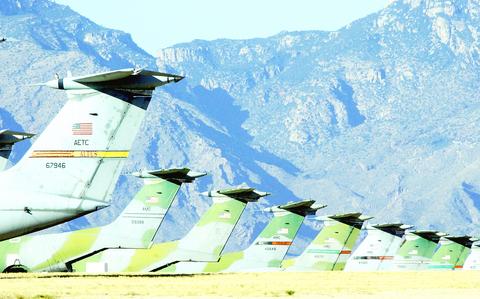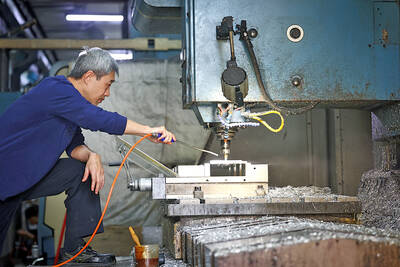As the Pentagon rushes a handful of B-1B bombers to the Persian Gulf for possible action against Iraq, two dozen more of the sleek warplanes face a very different fate: the Air Force's Boneyard here.
Spread over 2,600 acres at this base in the Sonora Desert in Tucson, nearly 4,400 decommissioned airplanes and helicopters from all the armed services have found a resting place, their destinies ranging from becoming aluminum ingots to someday serving under a foreign flag.
The B-1Bs, recently mothballed under an Air Force consolidation, will be stored for future use or cannibalized for their parts. Scores of Vietnam-era F-4 Phantoms are being refurbished for duty as remote-control drones that Air Force fighters will use for target practice. Aging B-52s, whose engines, avionics and landing gear have been picked clean, have been sold for scrap at US$0.25 a pound. Seats, throttles and other memorabilia end up on eBay.

PHOTO: NY TIMES
Missing his wings
"It's kind of sad," said Lieutenant Colonel Craig S. Harm, a former EF-111 pilot here, waxing wistful at the thought of his retired combat plane spray-wrapped in protective vinyl plastic and set out on the desert floor, perhaps to be salvaged for parts for the Australian Air Force.
The war in Afghanistan and the brewing conflict in the Persian Gulf have stepped up the military's need for spare parts and given the Boneyard, officially the Aerospace Maintenance and Regeneration Center, a role in the war against terror. Electronic and engine parts for Navy FA-18s are in especially high demand, officials said.
An afternoon drive through the row upon row of aircraft here in the shadow of the Santa Catalina Mountains is also a cruise through American military aviation history.
One of the F-111s that attacked Libya in 1986 is being stored here for the Air Force Museum in Dayton, Ohio. The 28 F-16 attack planes that Pakistan bought in the 1980s from the US but never received, because Congress withheld them to punish Pakistan for secretly developing nuclear weapons, are now being transferred to the US Navy and Air Force.
Famous visitors
The Enola Gay, the plane that dropped the atomic bomb on Hiroshima, stayed here briefly before ending up in the Smithsonian's Air and Space Museum.
Alongside the famous planes are scores of anonymous transport aircraft sitting forlornly in long columns, as well as an eclectic array of planes that look as if they were emptied from Air Force and Navy attics.
Experimental aircraft sit in a row like giant dodos. A C-130 equipped with huge skis, which was abandoned in Antarctica for 17 years and then rescued, now calls the Boneyard home. The original tooling equipment for the B-2 bomber is crated and laid out on the desert floor.
The remains of an A-10 Warthog that the Air Force says Captain Craig Button deliberately flew into a Colorado mountainside in 1997 are also here. "That's the more sensitive side," said Terry Vanden-Heuvel, spokeswoman for the Boneyard.
The military has used this base to store retired aircraft since 1946, when officials needed a place to park B-29s and C-47s after World War II. The area's arid climate and alkaline soil allowed the military to store aircraft here with a minimum of deterioration and corrosion. In addition, the soil here is unusually hard, making it easy to park and tow aircraft without having to build and maintain concrete or steel parking ramps.
Preservation
Before an aircraft is parked here, it goes through a preservation process. Workers remove guns, ejection-seat charges and classified equipment. Maintenance crews then drain the aircraft's fuel system and pump it full of lightweight oil. That is drained, leaving an oil film that protects the system.
Engine intakes, exhausts and any other gaps or cracks are taped over. Workers then spray the covered areas with a vinyl plastic that helps keep out dust and water and keeps the internal temperature of the aircraft within about 15 degrees of the external temperature to help preserve rubber, plastic and electronic components.
About 70 kinds of aircraft are stored here, and their ranks have fluctuated over the years, peaking at 6,000 after the Vietnam War.
"It surges after each war," said Jeffrey K. Wilson, the aircraft division chief, who is retiring this week after 35 years here. "War takes its toll on the weapons systems."
International agreements have also consigned aircraft to the chopping block. In the 1990s, the Strategic Arms Reduction Treaty, known as Start, called for the elimination of about 365 B-52s. At first, workers used a huge crane and a 6 tonne guillotine to do the trick. But now they use a special circular saw that allows some parts to be salvaged.
Foreign buyers
Not all planes are destined for the scrap heap. About 20 percent are eventually reactivated and sold to foreign countries or recalled to service. The Italian Air Force is taking delivery of F-16s refurbished here. Some O-2s, Vietnam-era propeller planes, have been converted into antipoaching planes in Africa.
Under the shade of a canopied maintenance shelter, some of the nearly 300 aircraft mechanics here were putting refurbished wings on A-10 Warthogs one day last week.
In a distant corner of the Boneyard, the littered wreckage of several assorted planes is the bleakest sight. The FBI uses the carcasses to rehearse airplane hostage rescues, shooting up the aircraft in the process.
No problem, really. When the agents are done, damage repair crews use the battered aircraft to test their skills at patching planes shot up in war zones.

SEEKING CLARITY: Washington should not adopt measures that create uncertainties for ‘existing semiconductor investments,’ TSMC said referring to its US$165 billion in the US Taiwan Semiconductor Manufacturing Co (TSMC, 台積電) told the US that any future tariffs on Taiwanese semiconductors could reduce demand for chips and derail its pledge to increase its investment in Arizona. “New import restrictions could jeopardize current US leadership in the competitive technology industry and create uncertainties for many committed semiconductor capital projects in the US, including TSMC Arizona’s significant investment plan in Phoenix,” the chipmaker wrote in a letter to the US Department of Commerce. TSMC issued the warning in response to a solicitation for comments by the department on a possible tariff on semiconductor imports by US President Donald Trump’s

The government has launched a three-pronged strategy to attract local and international talent, aiming to position Taiwan as a new global hub following Nvidia Corp’s announcement that it has chosen Taipei as the site of its Taiwan headquarters. Nvidia cofounder and CEO Jensen Huang (黃仁勳) on Monday last week announced during his keynote speech at the Computex trade show in Taipei that the Nvidia Constellation, the company’s planned Taiwan headquarters, would be located in the Beitou-Shilin Technology Park (北投士林科技園區) in Taipei. Huang’s decision to establish a base in Taiwan is “primarily due to Taiwan’s talent pool and its strength in the semiconductor

Industrial production expanded 22.31 percent annually last month to 107.51, as increases in demand for high-performance computing (HPC) and artificial intelligence (AI) applications drove demand for locally-made chips and components. The manufacturing production index climbed 23.68 percent year-on-year to 108.37, marking the 14th consecutive month of increase, the Ministry of Economic Affairs said. In the first four months of this year, industrial and manufacturing production indices expanded 14.31 percent and 15.22 percent year-on-year, ministry data showed. The growth momentum is to extend into this month, with the manufacturing production index expected to rise between 11 percent and 15.1 percent annually, Department of Statistics

An earnings report from semiconductor giant and artificial intelligence (AI) bellwether Nvidia Corp takes center stage for Wall Street this week, as stocks hit a speed bump of worries over US federal deficits driving up Treasury yields. US equities pulled back last week after a torrid rally, as investors turned their attention to tax and spending legislation poised to swell the US government’s US$36 trillion in debt. Long-dated US Treasury yields rose amid the fiscal worries, with the 30-year yield topping 5 percent and hitting its highest level since late 2023. Stocks were dealt another blow on Friday when US President Donald